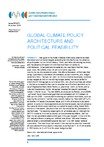Three gaps in the Kyoto Protocol most badly need to be filled: the absence of emission targets extending far into the future, the absence of participation by the United States, China, and other developing countries, and the absence of reason to think that members will abide by commitments. To be politically acceptable, any new treaty that fills these gaps must, we believe, obey certain constraints regarding countrybycountry economic costs. We offer a framework of formulas that assign quantitative allocations of emissions, across countries, one budget period at a time. The twopart plan: (i) China and other developing countries accept targets at BAU in the coming budget period, the same period in which the US first agrees to cuts below BAU; and (ii) all countries are asked in the future to make further cuts in accordance with a formula which sums up a Progressive Reductions Factor, a Latecomer Catchup Factor, and a Gradual Equalization Factor. An earlier proposal for specific parameter values in the formulas Frankel (2009), as analyzed by Bosetti, et al (2009) achieved the environmental goal that concentrations of CO2 plateau at 500 ppm by 2100. It succeeded in obeying our political constraints, such as keeping the economic cost for every country below the thresholds of Y=1% of income in Present Discounted Value, and X=5% of income in the worst period. In pursuit of more aggressive environmental goals, we now advance the dates at which some countries are asked to begin cutting below BAU, within our framework. We also tinker with the values for the parameters in the formulas. The resulting target paths for emissions are run through the WITCH model to find their economic and environmental effects. We find that it is not possible to attain a 380 ppm CO2 goal (roughly in line with the 2°C target) without violating our political constraints. We were however, able to attain a concentration goal of 460 ppm CO2 with looser political constraints. The most important result is that we had to raise the threshold of costs above which a country drops out, to as high as Y =3.4% of income in PDV terms, or X =12 % in the worst budget period.
CMCC InstitutesCMCC Divisions
Authors
- Keywords: Kyoto Protocol


